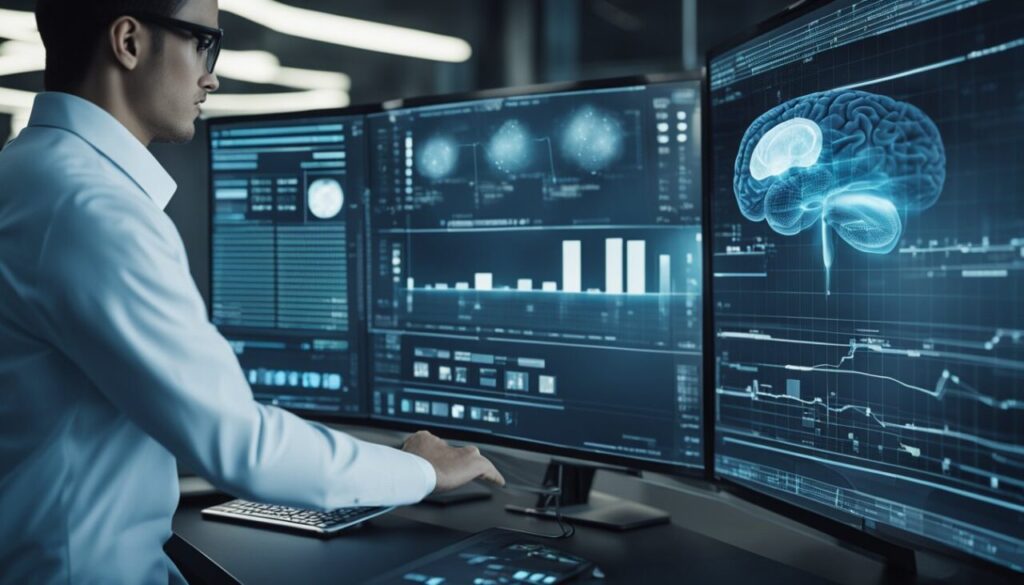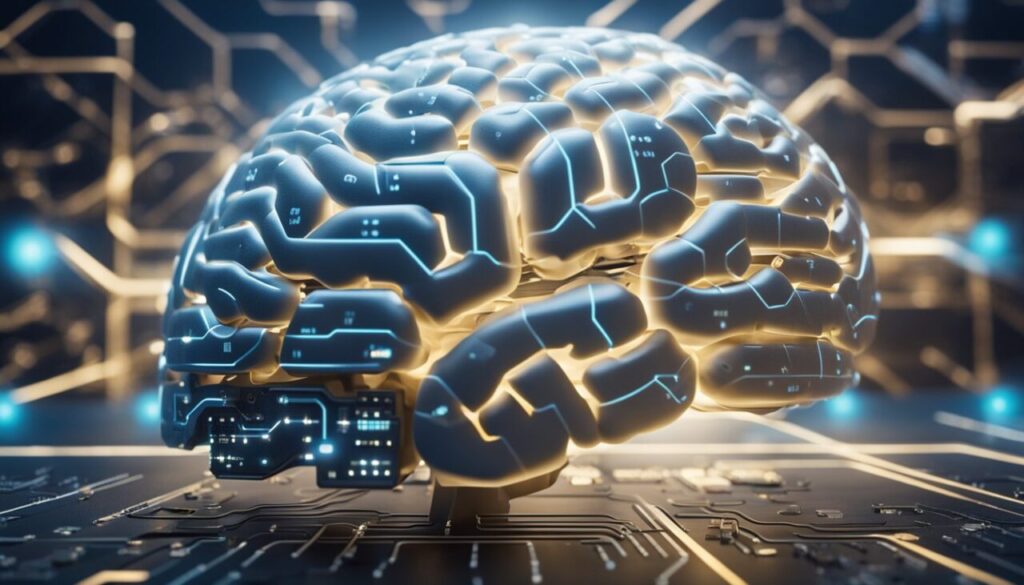
People always liked to imagine – what would be like to be able to read someone’s mind. And while this idea has been only part of pure science fiction, in the modern world this is becoming almost reality.
Namely, in recent years, there has been a surge in early developments of mind-reading technologies. With advancements in neuroscience and artificial intelligence, some experts believe that it may be possible to read people’s thoughts in the future.
However, there are still many open questions and uncertainties.
One of the main challenges of mind-reading technology is the complexity of the human brain. While brain scans can provide some insights into a person’s thoughts and emotions, there is still a lot that scientists do not understand about how the brain works.
Moreover, thoughts are not always clear and can be influenced by a range of factors, including emotions and external stimuli.
For example, the thoughts and brain waves of a sober person can be completely different than those of a person under the influence of psychedelics.
Interesting fact: In 2019, a team of researchers from the University of California, San Francisco, developed a system that can decode speech from brain activity in real time. The system was able to produce a rough version of what a person was saying by analyzing their brain waves. While the technology is still in its early stages, it could have implications for people who are unable to speak due to paralysis or other conditions.
The Concept of Thought Reading

Historical Context
The idea of thought reading has been around for centuries, with early mentions even in ancient Greek and Chinese texts. Then in the 19th and early 20th centuries, spiritualists claimed to be able to read thoughts through psychic abilities.
However, these claims were largely debunked by scientific investigations.
Current Understanding of Thoughts
In modern times, the concept of thought reading has shifted towards the use of technology. Scientists have been able to use brain imaging techniques to decode brain activity and predict what a person is thinking about. This has led to the development of brain-computer interfaces that allow people to control devices with their thoughts.
Overall, while the concept of thought reading may seem like science fiction, advances in technology have made it a reality in some forms. However, we’re still far away from practical applications in daily life.
So let’s first list all technologies that are currently somehow related to mind or thought reading.
List of All Mind Reading Technologies Currently In Development

There are numerous mind-reading technologies currently in development, each with its own unique approach and level of advancement.
Here is a list of some of the most promising ones:
- Functional Magnetic Resonance Imaging (fMRI): This technology uses magnetic fields to track the flow of blood in the brain, allowing researchers to identify which areas of the brain are active during certain tasks or thoughts. While fMRI is not a direct method of mind-reading, it can provide interesting insights into a person’s mental state.
- Electroencephalography (EEG): EEG measures the electrical activity of the brain using electrodes placed on the scalp. This technology can be used to detect changes in brain activity associated with different mental states, such as attention or relaxation.
- Magnetoencephalography (MEG): MEG measures the magnetic fields produced by electrical activity in the brain. Like EEG, it can be used to detect changes in brain activity associated with different mental states. MEG has the advantage of being more precise than EEG, but it is also more expensive and less widely available.
- Transcranial Magnetic Stimulation (TMS): TMS uses magnetic fields to stimulate specific areas of the brain. This technology can be used to temporarily disrupt or enhance brain function, providing insights into the role of different brain regions in mental processes.
- Brain-Computer Interfaces (BCIs): BCIs allow people to control computers or other devices using their thoughts. These devices typically use EEG or other brain imaging technologies to detect changes in brain activity associated with different mental states. BCIs have the potential to revolutionize the way we interact with technology, but they are still in the early stages of development. Probably the most famous BCI is Elon Musk’s Neuralink.
Overall, these mind-reading technologies are still in the early stages of development, and it is unlikely that any of them will be able to read thoughts with perfect accuracy in the near future.
But what about hundreds of years from now?
Let’s see…
Predictions for Future

Predictions for 2030
By 2030, it is possible that brain-computer interfaces will become more advanced, allowing for more accurate and detailed readings of brain activity. This could lead to the development of devices that can interpret thoughts and emotions with greater accuracy. One expert, Dr. John Donoghue, director of the Wyss Center for Bio and Neuroengineering, believes that “within the next decade, we will be able to decode speech directly from the brain.
Predictions for 2050
By 2050, it is possible that mind-reading technology will have advanced to the point where it is more widely available and affordable. This could lead to a range of applications, including improved communication for people with disabilities, enhanced security measures, and even new forms of entertainment.
Predictions for 2100
By 2100, some kind of mind-reading technology will be widely available, much like today’s smartphones. This could lead to major changes in how people communicate, work, and interact with each other. However, new ethical and legal frameworks will need to be developed to address the implications of mind-reading technology. Just imagine that suddenly, everyone can read each other’s minds. This would lead to complete chaos in the world. Almost all relationships would be broken, and people would not be able to be near each other at all – if the technology were so powerful that everyone could read each other’s minds 100% of the time.
Predictions for Thousand Years from Now
In a thousand years, brain-enhancing and mind-reading technology will be so advanced that it will fundamentally change what it means to be human. It is also possible that it will have unintended consequences that we cannot even imagine today.
Okay, so now that we’ve made some (far-fetching) predictions, let’s dive deeper into each of the currently available technologies.
Technological Advancements

Brain-Computer Interfaces
Brain-computer interfaces (BCIs) are devices that allow direct communication between the brain and a computer. This technology has advanced significantly in recent years, with researchers developing BCIs that can read and interpret brain signals with increasing accuracy. BCIs have the potential to revolutionize the way we interact with technology, enabling people to control devices with their thoughts alone. Implanted Electrode Arrays are one of many BCI methods. This method entails the placement of electrode grids directly onto the surface of the brain to capture neural activity. For instance, an individual like Ann, who is paralyzed due to a stroke, utilizes a Brain-Computer Interface (BCI) of this type to operate an avatar that communicates on her behalf.
Interesting fact: In 2012, a paralyzed person used a BCI to control a robotic arm with his thoughts and successfully drank a cup of coffee.
Machine Learning and AI
Machine learning and artificial intelligence (AI) are technologies that enable computers to learn and make decisions based on data. These technologies have the potential to enhance our ability to interpret and understand brain signals, making it possible to decode thoughts and emotions with greater accuracy. Machine learning and AI are already being used to develop algorithms that can predict a person’s thoughts based on their brain activity.
Interesting fact: In 2023, scientists from Radboud University and UMC Utrecht have achieved a breakthrough by converting brain signals into audible speech. Utilizing a blend of implants and AI, they decoded signals from the brain, enabling them to accurately anticipate the words individuals intended to articulate with a precision ranging from 92 to 100%.
MinD-Vis

MinD-Vis technology, also known as Sparse Masked Brain Modeling with Double-Conditioned Latent Diffusion Model for Human Vision Decoding, is a framework engineered to interpret human visual stimuli from brain recordings.
Here’s a simplified breakdown of its functionality:
- Sparse-Coded Masked Brain Modeling (SC-MBM): This initial stage entails developing a self-supervised representation of fMRI data. It employs masked modeling within an expansive latent space, drawing inspiration from the sparse coding principles observed in the primary visual cortex.
- Double-Conditioned Latent Diffusion Model (DC-LDM): In this subsequent stage, the model enhances a latent diffusion model with double-conditioning. This empowers MinD-Vis to reconstruct highly plausible images that align semantically with the specifics gleaned from brain recordings, all while utilizing minimal paired annotations.
This process aims to deepen our comprehension of the human visual system and lay the groundwork for linking human and computer vision via Brain-Computer Interfaces. The technology has demonstrated promising outcomes, surpassing state-of-the-art techniques in both semantic mapping and generation quality.
Neuroimaging Techniques
Neuroimaging techniques, such as functional magnetic resonance imaging (fMRI) and electroencephalography (EEG), allow researchers to measure brain activity non-invasively. These technologies have advanced significantly in recent years, enabling researchers to capture more detailed images of the brain and interpret brain signals with greater accuracy. Neuroimaging techniques are already being used to study a wide range of cognitive processes, including perception, attention, memory, and decision-making.
Interesting fact: In 2023, researchers used fMRI to decode the contents of a person’s dreams with 60% accuracy.
Overall, these technological advancements have the potential to revolutionize our understanding of the brain and how it processes information.
And while the ability to read thoughts with complete accuracy may still be some way off, these technologies are already enabling researchers to decode brain signals and gain insights into the workings of the mind.
But all of this comes with potential enormous problems both for individuals and humanity as a whole.
Brain-Computer Interfaces and Hacking

As the possibility of reading thoughts becomes more achievable, the issue of privacy becomes a major concern. The ability to access someone’s thoughts without their knowledge or consent could lead to a huge violation of their privacy rights.
This could have serious implications for individuals, particularly those who have experienced trauma or have sensitive information they do not wish to share.
The ability to read thoughts also raises big concerns about potential misuse. In the wrong hands, this technology could be used for wicked purposes, such as espionage, blackmail, or coercion.
Imagine this: a hacker gets into a Brain-Computer Interface (BCI) device, a direct line to your thoughts. It’s like they’ve broken into your mind’s inner sanctum. They’re not just stealing data; they’re messing with your very thoughts.
They could plant ideas in your head—false beliefs, irrational fears, even commands you’d feel compelled to follow.
And then complete fallout: suddenly, you can’t trust your own mind. What’s real, and what’s manipulation?
It’s like living in a twisted reality where someone else holds the strings to your thoughts and actions.
And it’s not just about you. This kind of mind-hacking could tear the sole fabric of society.
Let’s just hope this will not happen.
At least not anytime soon. And we can be sure of it (for now), as there are still many scientific challenges.
Scientific Challenges

Complexity of the Human Brain
Reading thoughts is a challenging process that requires a deep understanding of the human brain. The brain is an ultra-complex organ that consists of billions of neurons that are interconnected in a complex network.
Each neuron communicates with other neurons using electrical and chemical signals, and the patterns of these signals can encode information.
To read thoughts, scientists need to understand the patterns of neural activity that correspond to specific thoughts.
This is an impossible task (for now) because different thoughts can activate similar patterns of neural activity, and the same thought can be represented by different patterns of neural activity in different individuals.
Data Interpretation and Accuracy
Even if scientists can record the patterns of neural activity that correspond to specific thoughts, they still need to interpret this data accurately. This requires advanced algorithms that can decode the patterns of neural activity and translate them into meaningful information.
However, these algorithms are not perfect, and they can make errors in interpreting the data.
Moreover, the accuracy of the interpretation depends on the quality of the data, and it can be affected by factors such as noise, artifacts, and individual differences.
Hardware Limitations
Reading thoughts also requires advanced hardware that can record the patterns of neural activity with high spatial and temporal resolution. Current brain imaging techniques such as fMRI and EEG have limited spatial and temporal resolution, which means that they can only capture a fraction of the neural activity that is relevant for reading thoughts.
Moreover, these techniques are invasive and require the use of electrodes or contrast agents, which can pose risks to the subject’s health and well-being.
Developing non-invasive and high-resolution brain imaging techniques is a major challenge in the field of neuroscience.
Conclusion

In conclusion, the ability to read thoughts in the future is a topic that has been widely debated among scientists and the general public.
While there have been significant advancements in brain-computer interface technology, the idea of reading thoughts is still very far from being a reality.
It is important to understand that even if this technology becomes available in the future, there will be many problems that need to be addressed.
This technology will need to be implemented slowly over decades.
And it will be very important that this potential technology is democratized and available to everyone or to no one.
Just imagine the scenario where only the government or the wealthiest people possess these mind-reading devices.
Well then, all other people would be at a significant disadvantage. As mentioned in previous paragraphs, this would then in turn break society completely.
And so, it is rather important to approach this topic with caution and skepticism.
Perhaps as a society, we would need to decide not to advance this technology at all.
As one quote goes:
“Just because we can or build something doesn’t mean we should. Ability doesn’t mean prerogative.”




















